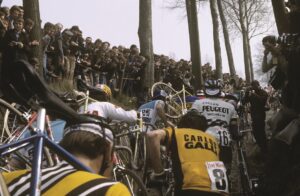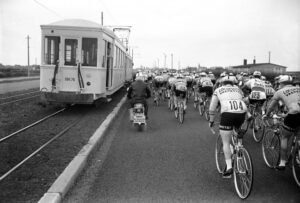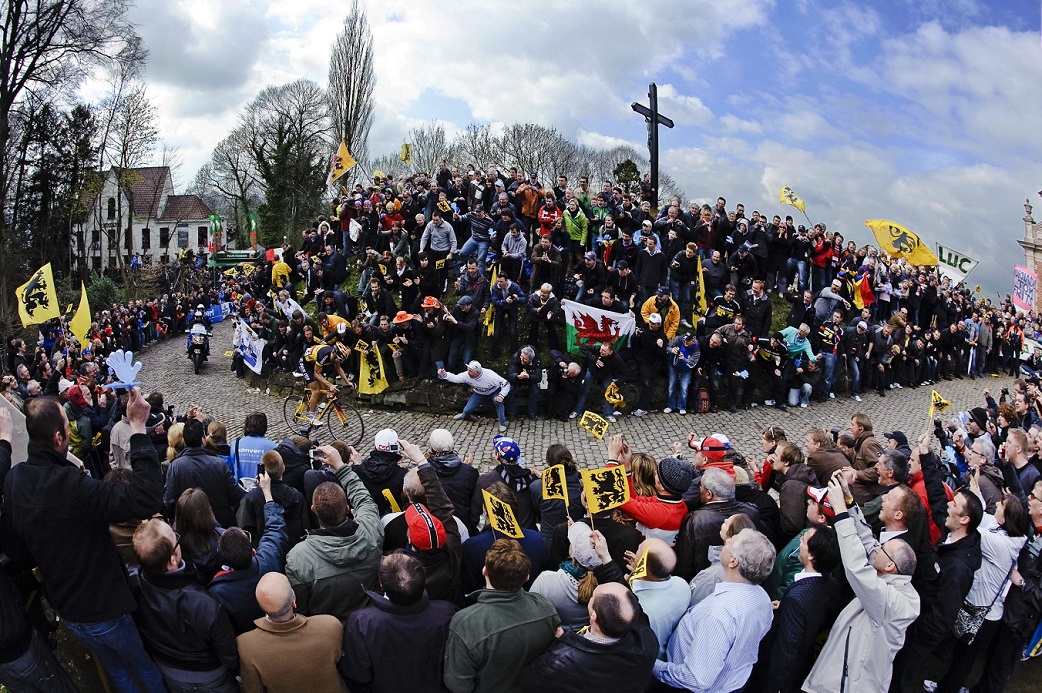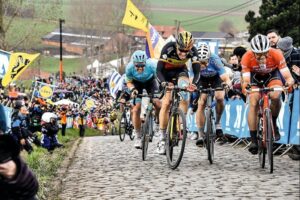Bike racing is in the air in Flanders, as unavoidable as the rain, as ubiquitous as pralines. Even those Flemings who claim to have no interest in cycling know ten times more about the sport than the average Anglophone. The information seeps into their subconscious via the blanket media coverage (most Flemish newspapers have daily cycling supplements during the season) and the chatter in cafes.
Even to the bike agnostics of Flanders names like Rik Van Looy, Roger de Vlaeminck, Johan Museeuw, Tom Boonen are as familiar as the names of the 1966 football World Cup-winning team are to England football fans. “I’m not interested in cycling,” they will say, then give a detailed analysis of Wout Van Aert’s chances in this weekend’s big race.
The Flemish obsession with cycling is so great some observers have compared it to a neurosis. At the centre of the madness are the Flemish classics, a series of brutal one-day races which commence with Omloop Het Nieuwsblad (on February 26 this year) and reach a wild and giddy climax on the first Sunday in April with the Ronde van Vlaanderen, a contest which, to the Flemish, is the Grand National, the FA Cup Final and Last Night of the Proms all rolled into one. In between are races big and small: Kuurne-Brussels-Kuurne, Nockere Koerse, Ghent-Wevelgem, Brugge-De Panne, Doors Dwar Vlaanderen and E3 Harelbeke (possibly the only sporting event on earth named after a section of motorway).
The Flemish races are a unique, pummelling test of endurance, raced over courses that sap stamina, jar teeth and break the will to live. They are characterised by sections of cobbles as gappy as a village idiot’s grin and so bumpy they can literally make a rider’s nose bleed and feature an exhausting series of short, sharp climbs up the hellingen of East Flanders. The names of these lumpy hills – Oud Kwaremont, Patenberg, Koppenberg, Taaienberg, Muur van Geraardsbergen – trip off the tongues of Flemish cycling fans as easily as the names of the noblemen in the Crispin’s Day speech to Shakespearean actors. Their legends are so great that several of them have their own websites.

At time, riders would carry their bikes up the hills.
As well as the cobbles and the hills the riders must also battle the weather. Over the years, this has featured gale force winds, sleet, fog, snow, ice and Biblical rains – sometimes all at once. The 2010 edition of Kuurne-Brussels-Kuurne, for example, was so cold, wet and windy that out of 195 riders who started the race only 26 reached the finish line, even though the course had been shortened from 200km to 180km to avoid fallen trees.
The Flemish could hold these already bruising events in August, when the temperature is balmy, the sky blue and the road surfaces have turned into treacherous mudslides pitted with potholes concealed by groundwater. But where would be the fun in that? And besides, every nation shapes its sport to test those character traits it admires most. The Flemish races examine strength, obduracy and fortitude. This is no place for fancy Dans with their sunglasses on their heads. The Flemish like riders with muscle, guts and, well, phlegm. If you haven’t shattered your collarbone at least once, they think you’re a coward.
Death Rider’s train wheeze
The Flemish love affair with bike racing stretches back over a century. It was sparked by a brush factory worker from Rumbeke named Odiel Defraeye who won the 1912 Tour de France (and the fortune that came with it) and kindled by a journalist from the outskirts of Torhout, Karel van Wijnendaele. Inspired by his fellow editor, Henri Desgrange of L’Auto who had launched the Tour de France in 1903, van Wijnendaele organised the Ronde van Vlaanderen. The first edition of which was raced in May 1913.
Unlike the Tour de France, which had multiple stages, the Tour of Flanders was a one-day race of roughly 320km (now it’s around 290km). It also had a political edge. Van Wijnendaele was a Flemish patriot and his new race was a celebration of the culture of his beloved Flanders, a day of national pride where the yellow-and-black lion flags would be waved as enthusiastically as the star bangled banner at the Superbowl.
Van Wijnendaele hoped that the Ronde would give the Flemish public a new breed of heroes to admire and emulate. His wish first came true in 1919 in the unlikely form of Henri ‘Ritten’ Van Lerberghe, a soldier from West Flanders with the moustache and bemused expression of a silent comedy star. Ritten was a rank outsider, riding a bike he had borrowed from his brother-in-law. He had a reputation of going off fast and then running out of puff (in honour of his kamikaze-style the local hacks called him “The Death Rider from Lichtervelde”). Naturally then, when Ritten belted away from the field at the start of the race the other riders simply joked about his suicidal tactics and let him go.
But then a stroke of good fortune befell The Death Rider: a train pulled to a halt right across the course. The resourceful Ritten picked up his bike and – or so legend has it – clambered in through one door and out through the other, then went on racing. The train was stationary for a long time. The pursuing riders did not have Van Lerberghe’s ingenuity. They simply stopped and waited for the train to roll on.
By the time he arrived at the velodrome in Gentbrugge where the race finished, Ritten was so far ahead of the others he decided he had time to call in at a nearby café and have a beer. Then he had another one. Then he had a third. Eventually, he decided it was time to make his way to the finish, but by now he was so drunk he had to be escorted around the track by an official. It was the stuff of which legends are made. The tale of the tipsy Death Rider on the borrowed bike cemented the Ronde van Vlaanderen in the consciousness of the Flemish people.
Iron Briek’s turkey thighs
If Ritten Van Lerberghe had done most to establish the Ronde, it was a later idol who would epitomise all the rugged characteristics of Flemish bike racing. The Ronde winner in 1942 and 1948, Briek Schotte had grown up on a farm near Kortrijk, developing his unholy strength as a boy by pedalling to and from school with several siblings perched on his bike. ‘Iron Briek’ was the archetypal Flemish roadman: short of stature with the bulky powerful torso of a tugboat and thighs like a couple of oven-ready turkeys.

Briek Schotte
While riders from other countries such as the Italian Fausto Copi, Luxembourg’s Charlie Gaul, or Jacques Anquetil of France rode their bicycles with the poise and elegance of catwalk models, Schotte hammered away at the pedals as if his legs were the pistons of some misfiring Victorian traction engine. His elbows jutted, his body rolled, the contortions of his face brought to mind the gurning peasants from a Brueghel masterpiece. It didn’t matter, though, because Schotte had the heart and power of a plough horse. In the mud and the sleet, he kept thudding away, soaked to his underwear and coated in filth, long after his stylish rivals began begging for mercy and the warmth of a fire. “I liked it when I suffered,” Schotte later said, “Because I knew that if I was suffering then all the rest of them were dead”.
Iron Briek was tough as teak and as unpretentiously and heartily Flemish as a bottle of brown ale and a bowl of stoemp. Despite being one of the greatest riders of his generation, Schotte remained down to earth and humble, happy to return home from a racing triumph and go straight out to snag turnips in the fields. When the council in his home village of Kanegem asked his permission to erect a statue in his honour, he agreed on two conditions: that it was no bigger than life-size and it wasn’t placed on a pedestal.

Riding past a tram
This homeliness and modesty are key elements of the true Flemish bike racing hero. Immediately three-times Ronde winner, Johan Museeuw retired from racing for the Italian GB Mapei team he abandoned his villa near Siena and moved back to his hometown of Gistel. When asked about the reasons for that decision he looked baffled: who would live in Tuscany if West Flanders was an option? Italian, French and Spanish who win big races celebrate with their entourages in chic restaurants. When Edwig Van Hooydonck won his first Ronde van Vlaanderen in 1989 he took his Mum and Dad to the local frituur for a big plate of sausage and chips.
Family is the core of Flemish racing. You see the parents and grandparents of the cyclists sitting by the roadsides at every race, flags celebrating their kin flapping from the flagpoles of camper vans or emblazoned on stickers across the back windows of Skoda Octavias. They plaster cuts, massage tired legs, hug the defeated and remind the winners that they still have a lot to learn.
As a youngster, Museeuw trained by following his father who rode ahead of him on a moped (it’s on display in the little Museeuw cycling museum in Gistel). When Schotte won the world road race championship in the Netherlands in 1948, he endeared himself to the nation by seizing the microphone from the radio interviewer and shouting “Mother, mother, can you hear me? I have won and I have become world champion!” He was 28-years-old at the time.
Schotte’s earliest memory from childhood was watching the Ronde pass through his village on the Sunday he attended his first mass. He died on the morning of the race in 2004. “Cycling is religion,” Iron Briek said. In Flanders, it surely is.


